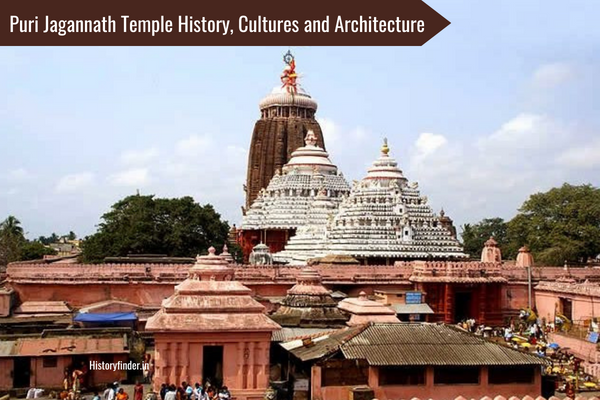Konark Sun Temple features among the top most heritage temple architectures of Odisha, India. Representing the chariot of Hindu Sun god, the gorgeous monument is also regarded among the oldest Sun temples in India. But the most glorifying fame of Konark Sun Temple lies in its intricate artwork symbolizing spiritual devotion. In short, Konark Sun Temple is a magnificent blend of incredible history, remarkable architecture and exquisite artwork.
Populated with more than 700 temples, the state of Odisha is also famous as ‘the land of temples’. But Konark Sun Temple is still valued among the best temples in Odisha. top 10 tourist destinations of Odisha for its architectural brilliance. In 1984, the World Heritage Committee declared the Sun Temple of Konark as a Word Heritage Site.
Konark Sun Temple is often regarded as Surya Mandir, Arka Khetra and Padma Khetra in local Oriya or Hindi languages. The main Konark Sun Temple idol is missing today. But the popularity of Konark Sun Temple is still intact, only shifting from devotion to history, art and architectural side.
Konark Sun Temple: Sources of Information
Historical texts, local legends, and accounts of travelers remained the oldest sources of information about Konark Sun Temple. The “Madala Panji”, a chronicle of the Jagannath Temple in Puri, provides details about the temple’s construction. It also describes the temple as a colossal chariot of the Sun God, symbolizing the cosmic journey of time and life.
The Ain-i-Akbari, by Abul Fazl, a court historian of Emperor Akbar, mentions the temple as the “Black Pagoda”. Additionally, folklore and oral traditions recount the contributions of the chief architect Bishu Maharana. The book is also a testimony of many legends surrounding the temple’s incomplete construction.
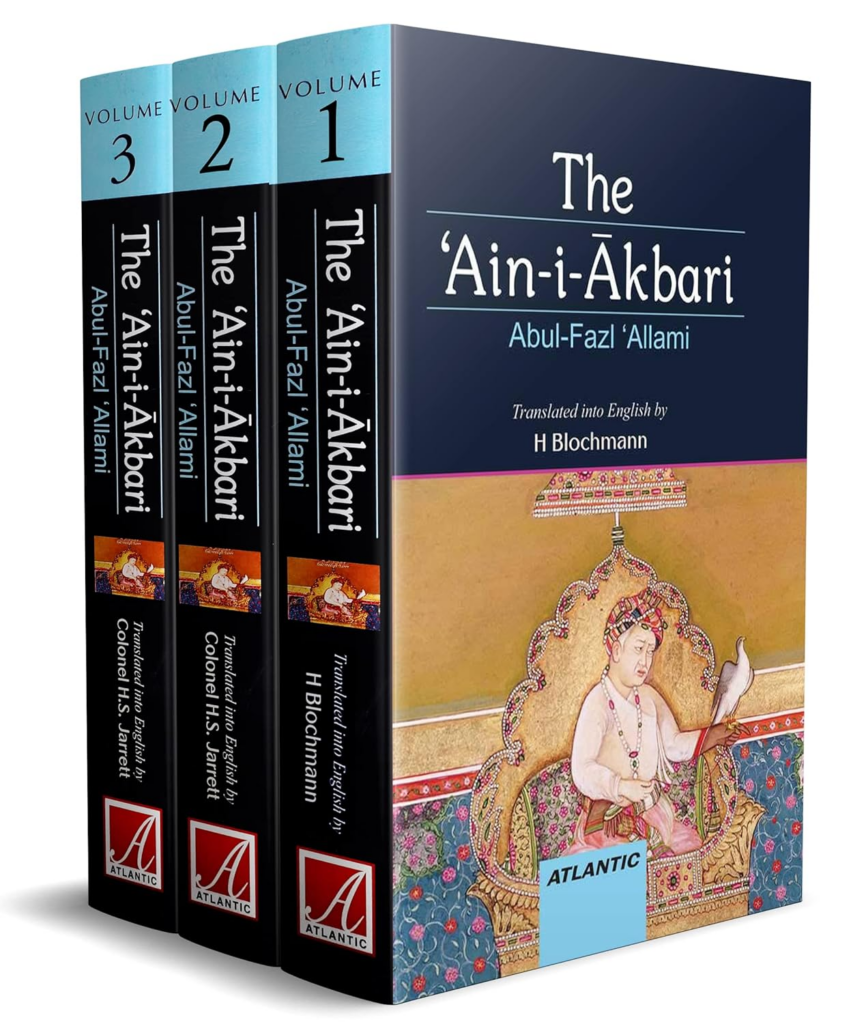
Early European travelers and colonial-era historians including James Ferguson documented the temple’s architectural grandeur, intricate carvings, and spiritual significance. These accounts, merged with archaeological studies, offer a rich history, artistry, and cultural importance of Konark Sun Temple.
18 Captivating Information on Konark Sun Temple History
The wondrous Konark Sun Temple featuring 800 years of history, is full of curious legends and facts. It unfolds many hidden information about the legendary Konark Sun Temple. But sometimes, they lack proper historical base. Nevertheless, these 18 astonishing facts will definitely leave you wondering:
1. Mystery on Konark Sun Temple Foundation
Archaeological evidences and historical records suggest that the temple is more than 700 years old. Ganga dynasty king Narasimhadeva built the Konark Sun Temple around 1250 CE, to commemorate his victory over the Muslim invaders. King Narasimhadeva had appointed Bisu Maharana as the chief architect for the construction of the temple. Old Oriya scripts like Madala Panji and Baya Chakada also carry similar information about Konark Sun Temple foundation.
Interestingly, Ain-i Akbari, the Abul Fazl account, mentions that Konark Sun Temple was built around 850 CE. Archaeologists like James Fergusson had already supported this theory. Few scholars claim that Konark temple was built during 9th century, by a king belonging to the Buddhist Tantrayana. However, the mystery and debate on Konark Temple foundation is yet to be revealed.
2. Etymology of Konark
The meaning of word Konark lies in two adjoining Sanskrit words: Kona and Arka. In Sanskrit, Kona means angle and Arka means the Sun itself. Summing them up, the word Konark means the angle of the Sun. Konark Sun Temple Chakra (wheel) was designed to calculate time, using the angle of the Sun. Hence, many historians believe in this theory.
Some historians although differ in the etymology of Konark. They believe Ganga dynasty kings have referred the northeast corner of Puri, with the word Kona. Circumstantially, the Jagannath temple of Puri was built by the same Ganga dynasty of Odisha, about a century ago.

3. Time and Cost of Construction
King Narasimhadeva ordered to finish the temple construction within 12 years. Bisu Maharana, the chief architect of Konark temple had appointed 12,000 workers for the construction. But unfortunately, they proved themselves inefficient to finish the work on time.
There is no exact estimate of construction cost of Konark Sun Temple. But various legends mention that King Narasimhadeva had to invest all his revenues collected during the entire construction period.
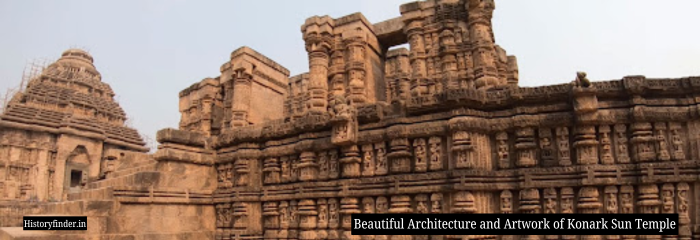
Konark Sun Temple was built using three types of stones. Konark temple sculptures, doors and frames were made of Chlorite. Use of Laterite stones are visible for temple platforms and staircases. Other areas of the temple have use of Khondalite rocks. Majority of rocks and stones were brought from Udaigiri and Khandagiri hills.
4. Why Left Incomplete?
Historical evidence suggests that the temple was never fully completed. Many historians claim that early death of king Narasimhadeva led stoppage in the construction of Konark. It never restarted again. Nevertheless, another theory claims, Bisu Maharana, the chief architect of Konark Sun Temple missed the deadline. It led the king ordering the stoppage of work.
Another legend around Konark Sun Temple describes about complications arrived installing the Dadhi Nauti, the crown stone of the temple. It caused a significant delay which led to missing the construction deadline. Willing to divert the king’s anger, Dharmapada, son of Bisu Maharana, jumped into river Chandrabhaga from the temple top. According to the experts, death of Dharmapada was one of strongest reasons why Konark Sun Temple construction was stopped. This Dharmapada story is also taken as the reason why Konark Sun Temple has never worshiped the god of Sun.
5. Myth of Chandrabhaga River
Many historical accounts call the existence of Chandrabhaga river aside Konark Sun Temple as only a myth. A folklore describes that Konark temple was built at the river mouth of Chandrabhaga river. King Narasimhadeva had to fill Chandrabhaga river gorge with giant stone blocks. Some scholars disagree mentioning two reasons. Firstly, no traces of Chandrabhaga river is found today. Secondly, even it did ever exist, no one would bother fill the land with huge stone blocks painstakingly. Rather, the king would easily select an alternate land, from many more options available.
6. Konark Temple Orientation
The orientation of Konark Sun Temple is the most notable feature of the most prominent temple architecture of Odisha. Remarkably, it symbolizes the god of Sun journey through the day, month and year. The first ray of sunlight would illuminate the temple main entrance first. Then, as the day progresses, the god of Sun continues his journey, the rear sections of the temple starts illuminating. Historical records describe it would then illuminate sanctum (ruined today), creating a spiritual vibe. Konark Sun Temple
7. A Gigantic Chariot
According to the Hindu Vedic mythology, Surya rises in the east and travels rapidly during the day. Seven horses drive his chariot from east to west through the sky. The temple is designed as a colossal chariot of the Sun God, Surya, with 12 pairs of exquisitely carved wheels and seven horses. Each wheel functions as a sundial, allowing time calculation based on the shadow cast by the spokes.
Seven horses of the Hindu god of Sun are namely:
- Gayatri,
- Brihati,
- Ushnih,
- Jagati,
- Trishtubha,
- Anushtubha, and
- Pankti
8. Time Calculation with Konark Sun Temple Chakras (Wheel)
Konark Sun Temple Chakras, the chariot wheels, hold immense architectural, cultural and symbolic significance. The intricate carvings represent marvelous artistry, with a prefect blend of spiritual and functional side of life. The most interesting part of the Konark chariot wheels are, represention of a sundial. The chariot of the god of Sun had 12 pairs of Chakras (wheels), representing 12 months of the year.
Each wheel has 8 thick and 8 thin spokes, representing 8 prahars (a three hour interval) and 8 half-prahars of a day. Each prahar is further subdivided by 60 smaller beads at the wheel periphery. They represent the smallest time intervals of 3 minutes each.
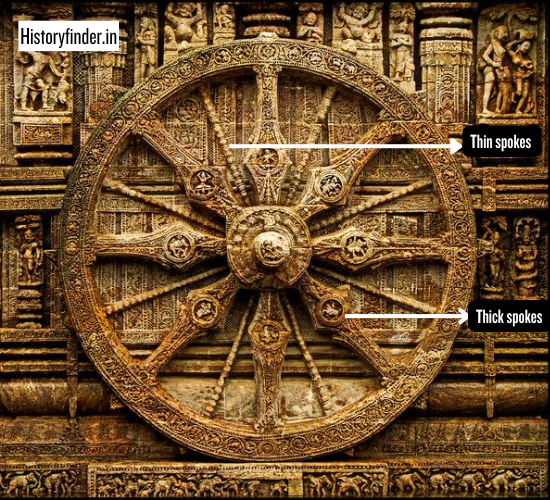
It is indeed surprising how one can measure exact time, with Konark Temple chariot wheel. You just need to put your finger on the axle of the wheel. The shadow of your finger falling on the spokes or the beads would determine the exact time of the day. So, Konark Temple chariot wheels are indeed a perfect blend of astronomical advancement, engineering accuracy and exquisite artistry.
9. Intricate Carvings Depicting Daily Life
Exquisite stone carvings appear on all over the temple walls. The carvings include purely decorative geometric patterns, plant motifs, marching soldiers, hunting scenes, caravans and carts etc. Temple terraces contain stone statues of male and female musicians, holding various musical instruments. Other artworks include sculptures of Hindu deities and apsaras.
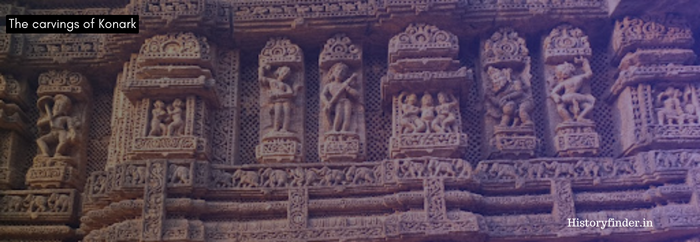
Konark Chariot carvings depict many Artha and Dharma scenes, the daily life and culture of the people. The daily life scenes include hunting, royal court scenes, musicians, and dancers, offering a cultural glimpse of 13th-century Odisha.
10. Significance of Konark Sun Temple Erotic Sculptures and Symbolism
The erotic sculptures of the Konark Sun Temple are not just artistic expressions. But hold profound cultural, philosophical, and spiritual significance. Kama (desire) is one of the four Purusharthas (goals of human life), alongside Dharma (righteousness), Artha (wealth), and Moksha (liberation). These sculptures represent the acknowledgment of human desires as a natural and celebrated aspect of life.
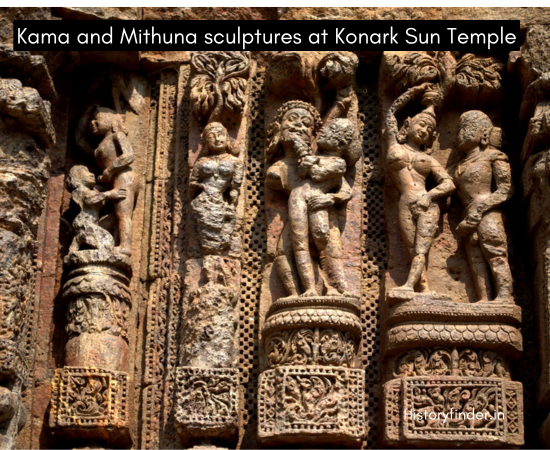
Many historians had claimed that Konark Sun Temple erotic sculptures may have served as an educational tool for medieval society. The Kama and Mithuna sculptures illustrate love and intimacy of relationships. Another probable reflection is the cultural openness, that encouraged balanced living, respecting all aspects of human existence.
11. Invasion by Kalapahad
Konark Sun Temple history is featured by several Muslim invasions. A folklore describes Kalapahad, a converted Muslim general, invaded Konark temple in 1568. Madala Panji described Kalapahad invading multiple Hindu temples in Odisha at that time. But there is no concrete evidence whether Kalapahad invaded Konark or not.
12. Marine Navigation of Medieval Era: Black Pagoda
Due to its adjacency to the coast, Konark temple had served as an important navigational landmark during medieval era. Black granite stones and unique architecture of Konark Sun Temple would appear like a black tall tower with multiple tiers. The 229 feet tall temple was easily visible for far and would navigation very easy for the sailors. European sailors had named Konark Sun temple ‘Black Pagoda’, for its blackish pagoda (multi-level tall tower) look.
Contextually, they called Jagannath temple of Puri as ‘White Pagoda’ for similar reasons.
13. Floating Idol mystery of Konark Temple
The legendary story of Konark Sun Temple floating idol is still a mystery today, lacking any archaeological evidence. According to folklore, the sanctum of Konark Temple once housed a giant idol of the Sun, floating in the air. Konark Sun Temple crowing stone (Kalasha) was said to be a 52 ton giant magnet. The Sun god’s idol was also said to be made of a special metal. It would create a magnetic field strong enough to hold the hold giant idol in the air.
The absence of the Konark Temple Shikhara and the surviving magnets today, make it difficult to verify any such claims. Further, truthfulness of such a large earthen magnet (magnetite) had always been questionable to the scholars. Nevertheless, despite the uncertainty, the Konark Sun Temple floating idol story remains a captivating aspect of the temple’s mystery.
14. Destruction by the Portuguese Sailors
The giant magnet crown stone of Konark temple is said to cause navigation problems to the Portuguese sailors. A legend mentions, it led the Portuguese sailors removed the Konark crown stone to avoid the problem.
Many historians, however, reject such claims. Despite the hugeness of the Konark magnet crown stone, causing navigation problems such far into the sea, didn’t seem practical. More importantly, no evidence of such removal was ever found. But, irrespective of the truthfulness, removal of Konark crown stone has remained major mystery of Konark Sun Temple history.
15. Symbolic Artistry of Konark Nara-Gaja-Simha Sculpture
Nara-Gaja-Simha (human elephant lion) sculpture of Konark Sun Temple is a remarkable representation of symbolic artistry. The iconic sculpture typically depicts a lion atop an elephant, both standing on a human figure.
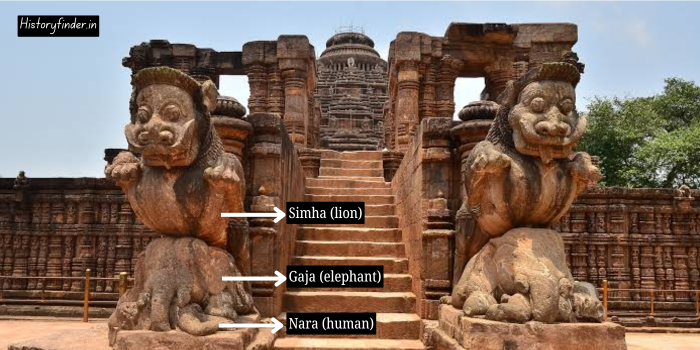
Lion, mount of Hindu goddess Durga, symbolizes the aggression or arrogance of human being. On the other side, elephant represent materialistic wealth. The Nara-Gaja-Simha sculpture hence symbolize how human desire of wealth and arrogance can ruin his life.
16. Konark Sun Temple Worship Controversy
Worship of Lord Suryanarayana is among the strongest controversies of Konark Sun Temple. Few historians believe that the temple was never completed or, collapsed soon after construction. Hence, the temple never worshiped the god of Sun. Their claim further strengthens with finding of many parts of Konark temple, never taken to the temple top.
But old Oriya accounts like Madala Panji mentions about completion of Konark temple construction. Hence, possibility of worship of the god of Sun is high. Similarly, Ain-i Akbari also never mentioned about ruined condition of Konark Sun Temple. Such facts made many scholars doubting the folklore that Konark Sun Temple had never worshiped Suryanarayana, the god of Sun.
Interestingly, Madala Panji describes about the distribution of responsibilities for various daily rituals and festivals conducted in the Sun Temple. It also describes increased allotment of funds by the King.
17. Removal of Sculptures
Aruna Stambha (Aruna pillar) once glorified the entrance of Konark temple. The 33 feet 8 inches (10.26 m) tall monolithic chlorite pillar was dedicated to Aruna, the charioteer of the Sun god. During late 18th century, Goswain, a Maratha Brahmachari, taken and installed at Singha Dwara of Puri Jagannath Temple.
Raja of Khurda during early 19th century, removed some stones and sculptures from Konark Temple. He used the sculptures to build a temple in Puri. Few gateways and sculptures were destroyed in the process.
In 1894 thirteen sculptures were moved to the Indian Museum. Later, accepting the demand of local Hindu population, the government stopped further removal of items from the temple.
18. Restoration and Preservation Initiatives
In 1803, the East India Marine Board requested the Governor General of Bengal to prohibit further removal of stones. It was the first initiative ever made for preservation of Konark Sun Temple. In 1903, J. A. Bourdillon, Lieutenant governor of Bengal, released order to seal and fill up Konark Temple Jagamohana with sand. Two years later, the structure of Mukhasala and Nata Mandir was also repaired.
Legacy of Konark Sun Temple
In summary, the Konark Sun Temple wheels are not merely architectural elements but a profound symbol of India’s heritage. It symbolizes India’s architectural genius and spiritual devotion. Designed as a chariot of the Sun God, it features intricate carvings depicting celestial beings, animals, and human life. Konark temple, representing the zenith of Kalinga architecture, showcases advanced engineering. Despite suffering partial collapse, Konark Sun Temple remains a cultural and historical icon, inspiring artists, poets, and pilgrims for centuries.

